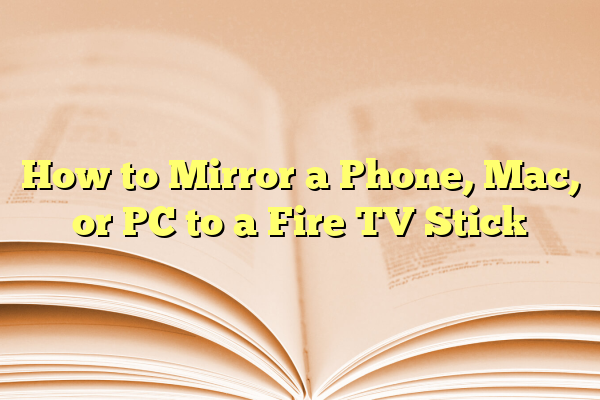
How to Mirror a Phone, Mac, or PC to a Fire TV Stick
Mirroring content from a smartphone, Mac, or PC to an Amazon Fire TV Stick is a convenient way to enjoy videos, photos, presentations, or games on a larger screen. While the process may differ slightly depending on the device and operating system, it’s usually simple once the correct steps are followed. This article provides a clear guide on how users can mirror their devices to the Fire TV Stick effectively.
Contents
What Is Screen Mirroring?
Screen mirroring refers to the ability to replicate a device’s screen on a TV or monitor. It allows users to project what is on their phone, laptop, or tablet to a much larger display wirelessly. Amazon Fire TV Stick supports this feature with native and third-party tools, depending on the device being mirrored.
Mirroring from an Android Phone
Many Android devices support screen mirroring using Miracast or a built-in casting function. Here’s how to mirror an Android phone to a Fire TV Stick:
- Ensure the Android phone and Fire TV Stick are connected to the same Wi-Fi network.
- On the Fire TV Stick, press and hold the Home button on the remote. Select Mirroring or Screen Mirroring from the menu.
- On the Android phone, go to Settings > Display > Cast or look for a Cast option in the quick settings panel.
- Select the Fire TV Stick from the list of available devices. The screen should now appear on the TV.

Mirroring from an iPhone or iPad
Apple devices use AirPlay, which is not natively supported by Fire TV devices. However, users can install apps like AirScreen on the Fire TV Stick to enable compatibility.
- Open the Fire TV Stick and go to the App Store, then search for and install AirScreen.
- Launch AirScreen and follow the on-screen prompts to begin broadcasting.
- On the iPhone or iPad, swipe into the Control Center and tap Screen Mirroring.
- Select the Fire TV Stick. The screen of the iOS device should appear on the TV shortly.
Mirroring from a Mac
To mirror a Mac to a Fire TV Stick, users again need to use the AirScreen app, since macOS also uses AirPlay.
- Install and launch the AirScreen app on the Fire TV Stick.
- On the Mac, click on the AirPlay icon in the menu bar at the top right of the screen.
- Choose the Fire TV Stick from the list of available devices.
- The Mac screen should begin mirroring to the Fire TV Stick-connected display.

Mirroring from a Windows PC
Most Windows PCs support Miracast, which works seamlessly with Fire TV Stick mirroring features.
- Ensure both the Windows PC and Fire TV Stick are on the same Wi-Fi network.
- On the Fire TV Stick, activate the Mirroring feature as described earlier.
- On the Windows PC, press Windows + K to open the Connect panel.
- Select the Fire TV Stick from the list of available devices.
- The PC screen will then be mirrored to the TV via the Fire Stick.
Tips for Smooth Screen Mirroring
- Keep both devices updated to the latest software versions.
- Make sure no VPNs are active as they can disrupt connectivity.
- For best results, maintain a strong Wi-Fi signal.
FAQs
- Q: Why can’t I find the mirroring option on my Fire TV Stick?
A: The screen mirroring option may be hidden or disabled based on the device model or firmware. Make sure the device is updated and try using third-party apps like AirScreen. - Q: Do I need internet to mirror my device?
A: While both devices need to be on the same Wi-Fi network, an active internet connection is not strictly necessary for simple mirroring. - Q: Is there a delay or lag during mirroring?
A: Some delay is normal, especially during gameplay or video. A stronger, faster Wi-Fi network can reduce the lag. - Q: Can I mirror audio as well?
A: Yes, most mirroring methods transmit both video and audio. Ensure your TV volume is up and not muted.
Mirroring to a Fire TV Stick can open up new possibilities for personal and professional use. With the right method and settings, users can enjoy seamless display across all major platforms.
